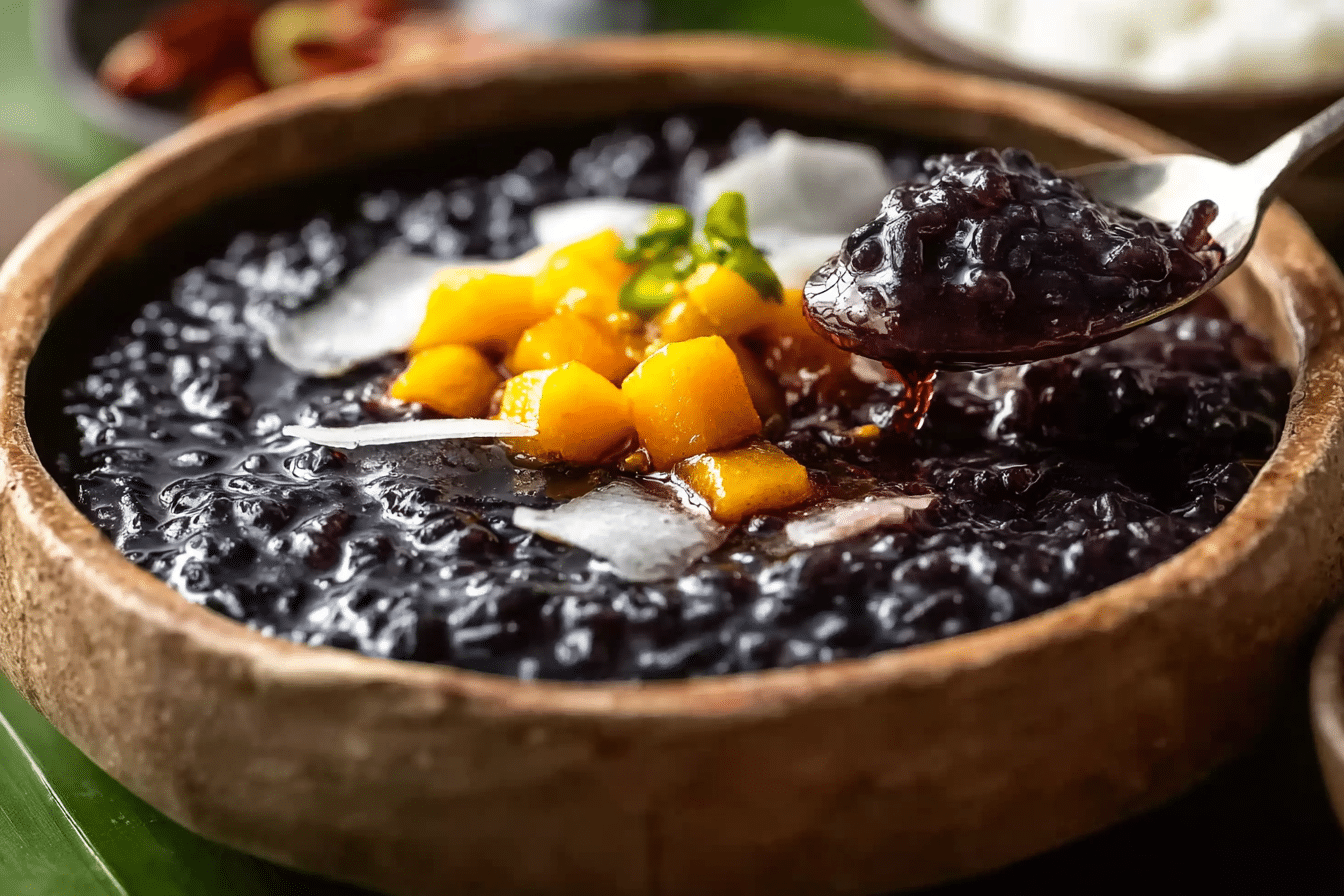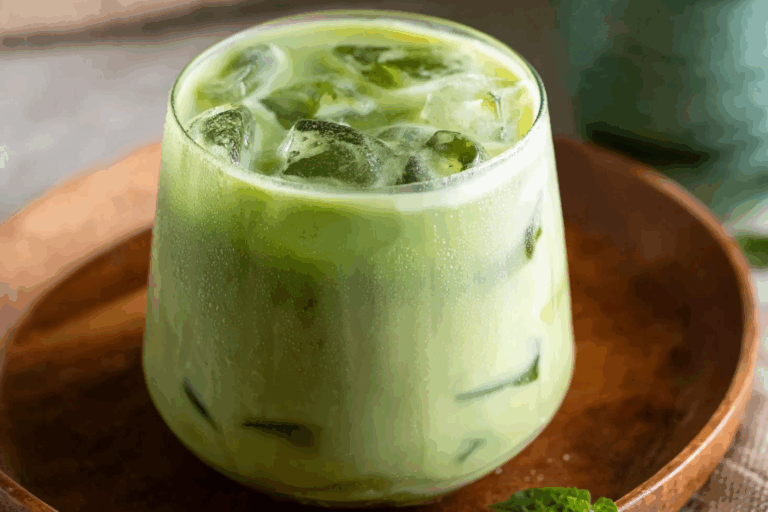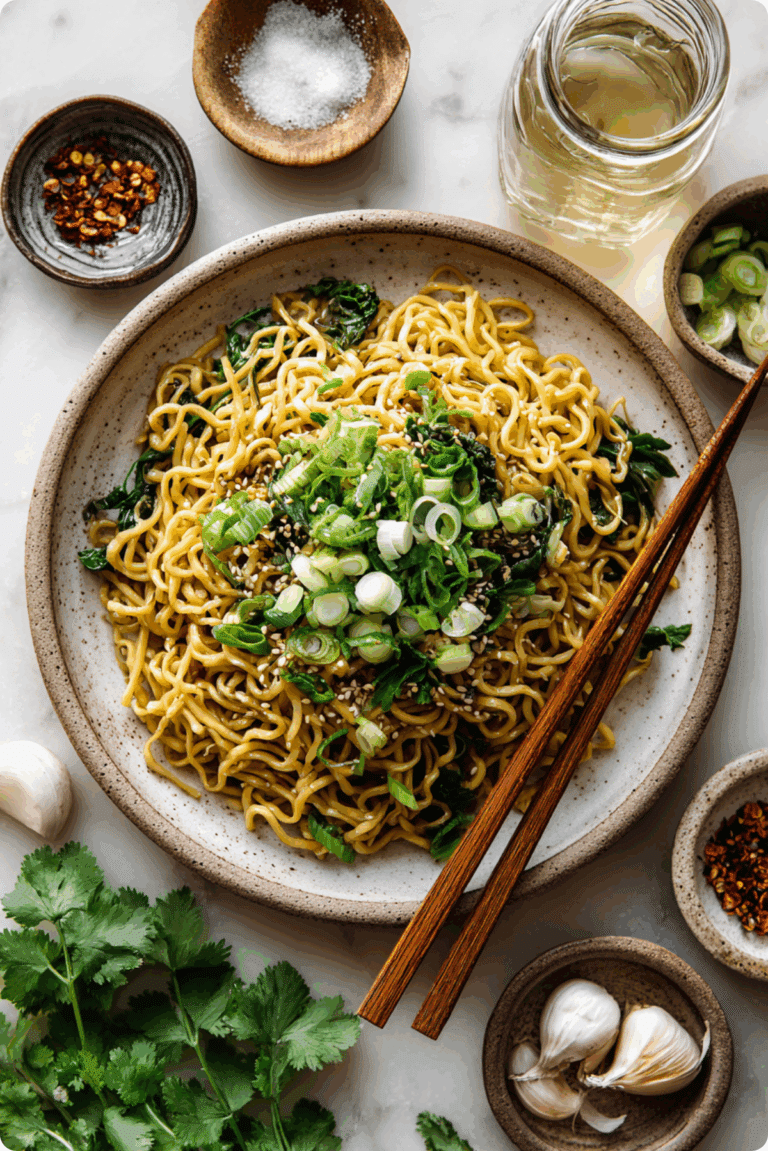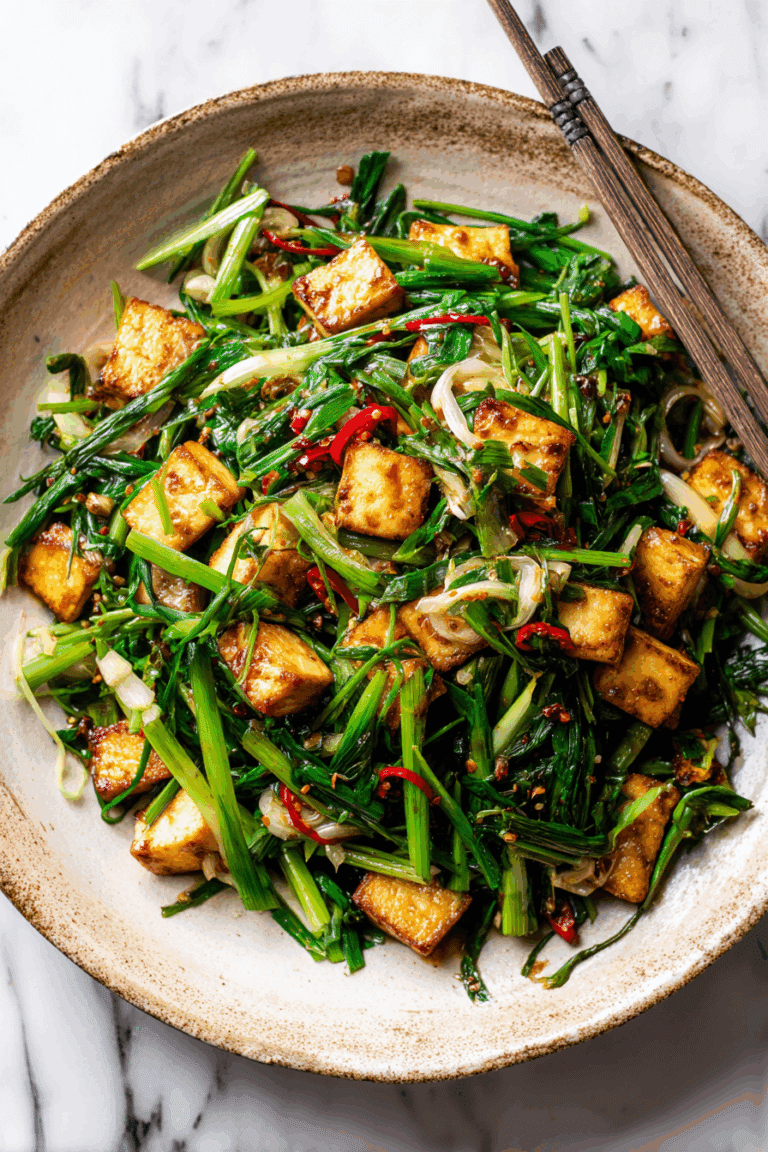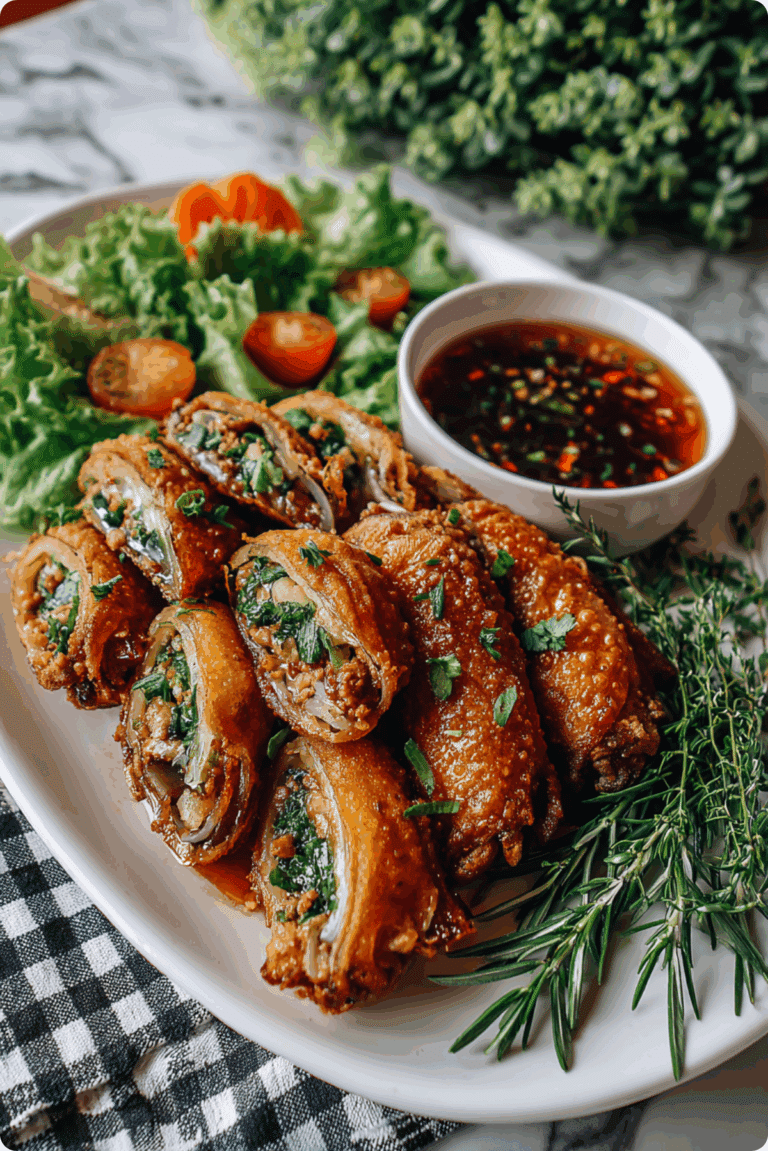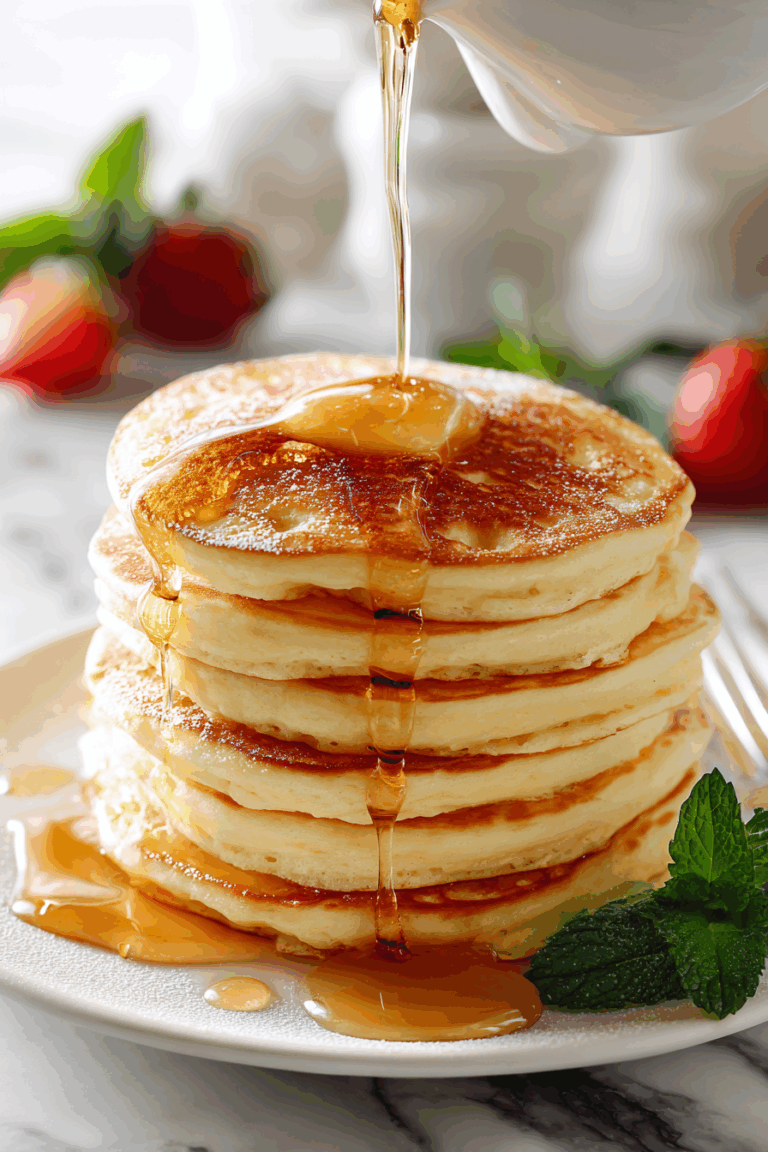Thai Black Sticky Rice Pudding: The Ultimate Guide To Make This Recipe
Thai Black Sticky Rice Pudding is a mouthwatering traditional Thai dessert that deserves a spotlight in your kitchen. With its nutty aroma, chewy texture, and rich coconut topping, this dish delivers comfort, flavor, and authenticity in every bite. But this isn’t just another sweet dish it’s a recipe with roots, history, and heart.
This beloved dessert is at the core of what Just Thai Recipes is all about. Lina, the passionate cook behind the website, began her culinary journey to share the bold, flavorful, and often nostalgic meals of her Thai heritage. From street-side eats to comfort food classics, her mission is to help home cooks experience the joy and vibrancy of Thai cuisine in their own kitchens. Thai Black Sticky Rice Pudding is one of those iconic recipes that represents everything she stands for flavor, authenticity, and cultural connection. You can feel her story in every spoonful.
Now, let’s explore the sweet world of Thai Black Sticky Rice Pudding, from its traditional roots to modern twists, with all the tips you need to make it perfectly at home.
Table of Contents
Table of Contents
What Is Thai Black Sticky Rice Pudding?
A Taste of Thailand’s Dessert Culture
Thai Black Sticky Rice Pudding, or khao niew dam, is a cherished sweet treat in Thai households and street food stalls alike. Unlike many Western puddings that rely heavily on dairy, this dessert features black glutinous rice, cooked until tender and thick, then sweetened with palm sugar and enriched with creamy coconut milk. The rice itself has a slightly nutty flavor and sticky texture that makes it both satisfying and addictive.
The pudding is traditionally served warm but can also be enjoyed chilled. Often topped with salted coconut cream, fresh mango cubes, or toasted coconut shavings, this dish walks a beautiful line between sweet and savory, creamy and chewy, simple and complex.
What Makes It Different From Other Rice Puddings
Most people are familiar with classic rice pudding, which usually involves white rice and milk. Thai Black Sticky Rice Pudding breaks that mold. First, it uses black glutinous rice—a naturally sticky grain that turns a rich purple color when cooked. This type of rice is not just visually stunning but also higher in antioxidants compared to white rice.
Then comes the flavor. Instead of dairy, this dessert leans on coconut cream, giving it a tropical edge. Palm sugar adds a deep caramel-like sweetness, which pairs perfectly with the nutty rice and creamy toppings. Together, these ingredients create a unique blend of flavors and textures that can’t be replicated with Western-style rice puddings.
Thai Black Sticky Rice Pudding is more than just a dessert. It’s an experience, steeped in tradition and bursting with authentic Thai flavor.
Print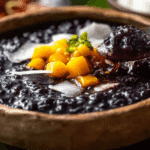
Thai Black Sticky Rice Pudding
- Prep Time: 4 hours (soaking)
- Cook Time: 30 minutes
- Total Time: 4 hours 30 minutes
- Yield: 4 servings 1x
- Category: Dessert
- Method: Stovetop
- Cuisine: Thai
- Diet: Vegetarian
Description
This Thai Black Sticky Rice Pudding is a rich, comforting dessert made with a blend of black and white glutinous rice, gently simmered with pandan leaves and sweetened with palm sugar. Topped with salty coconut cream and optional toasted coconut or mango, it’s a creamy, indulgent treat perfect for warm or cold servings.
Ingredients
- 1 cup black glutinous rice (black sticky rice)
- 4 tbsp white glutinous rice (white sticky rice)
- 4 cups water
- 2 pandan leaves, folded and knotted
- 1 cup palm sugar (or brown sugar), grated
- 1/2 tsp salt
- 1/2 cup coconut cream
- 1/8 tsp salt (for topping)
- 1/2 cup shaved coconut, toasted (optional)
- Mango cubes or crushed peanuts, for topping (optional)
Instructions
- Place both black and white glutinous rice in a bowl and cover with water about 2 inches above the rice. Soak for at least 4 hours or up to 12 hours.
- Drain the soaked rice and transfer it to a small pot or large saucepan.
- Add the knotted pandan leaves to the pot.
- Add 4 cups of cold water and bring to a boil. Reduce heat to low and simmer gently for 30 minutes without a lid, stirring frequently during the last 15 minutes and constantly toward the end.
- The rice should be fully cooked, soft, and the liquid thickened to a creamy consistency from the rice starch.
- Stir in grated palm sugar and 1/2 tsp salt until dissolved, about 20 seconds.
- Ladle the pudding into serving bowls. The consistency should be oozy and creamy, not runny or overly thick.
- Mix 1/2 cup coconut cream with 1/8 tsp salt and drizzle over the pudding.
- Top with toasted coconut, mango cubes, or crushed peanuts if desired. Serve immediately.
Notes
- Black glutinous rice gives the pudding its signature dark color and nutty flavor. White glutinous rice helps balance texture.
- Pandan leaves add a fragrant aroma but can be omitted if unavailable.
- Grated palm sugar offers a deep, caramel-like sweetness; substitute with brown sugar if needed.
- Toasted coconut and mango cubes add texture and tropical flavor to the final dish.
Nutrition
- Serving Size: 1 bowl
- Calories: 320
- Sugar: 18g
- Sodium: 160mg
- Fat: 10g
- Saturated Fat: 8g
- Unsaturated Fat: 2g
- Trans Fat: 0g
- Carbohydrates: 54g
- Fiber: 2g
- Protein: 4g
- Cholesterol: 0mg
Keywords: Thai black sticky rice pudding, black glutinous rice dessert, coconut sticky rice, Thai dessert, sweet sticky rice
Thai Black Sticky Rice Pudding Ingredients Explained
Understanding the Core Ingredients
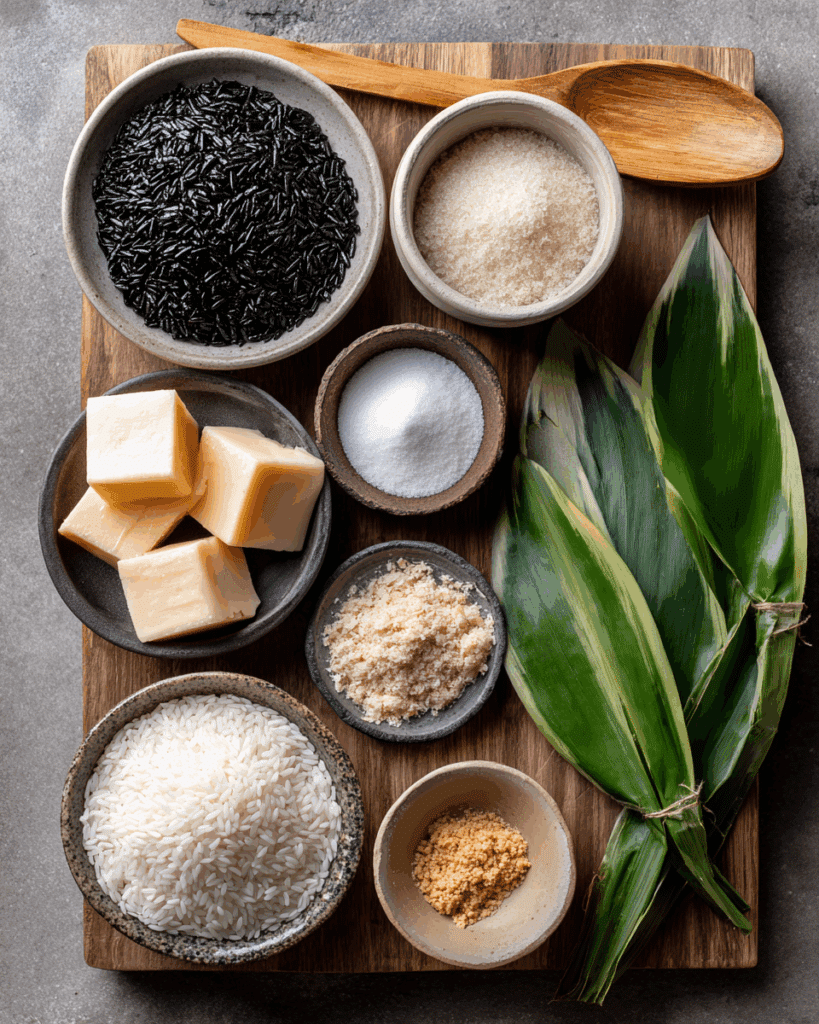
Every bite of Thai Black Sticky Rice Pudding tells a story one of texture, balance, and centuries-old Thai cooking tradition. To fully appreciate this dessert, it’s important to understand the ingredients that bring it to life.
Black Glutinous Rice (Black Sticky Rice)
This is the star of the dish. Known in Thai as khao niew dam, black glutinous rice is a naturally sticky grain that appears dark brown to purple when raw and turns an intense deep purple when cooked. Despite the word “glutinous,” it’s gluten-free. It provides not just chewiness, but also an earthy flavor and a beautiful color that gives the pudding its signature look.
Unlike standard white sticky rice, this rice is higher in fiber, iron, and antioxidants like anthocyanins—the same compounds that give blueberries their color. In Thailand, it’s widely used in both desserts and hearty dishes.
White Glutinous Rice (White Sticky Rice)
A small portion of white sticky rice is often added to improve the pudding’s overall texture. It softens the final dish and helps balance the chewiness of the black rice. It also thickens the pudding more evenly, especially if you’re aiming for that classic oozy, creamy consistency.
Water
The cooking liquid in this recipe is plain water. While some recipes use coconut milk to cook the rice directly, the more traditional approach simmers the rice in water and adds coconut cream only as a topping. This method enhances the natural flavor of the rice without overpowering it.
Pandan Leaves
These long, fragrant green leaves are a common ingredient in Thai desserts. Tied into knots and simmered with the rice, pandan leaves infuse the pudding with a subtle, floral aroma that many describe as slightly nutty or grassy. If you can’t find fresh pandan, frozen leaves work well too, and pandan extract can be used as a backup.
Palm Sugar or Brown Sugar
Palm sugar, made from the sap of palm trees, has a deep, caramelized flavor that enhances the richness of the pudding. It’s soft, moist, and typically comes in block or paste form. If unavailable, dark brown sugar makes a decent substitute.
Palm sugar dissolves into the pudding during the final minutes of cooking, bringing a mellow sweetness and golden tone to the dish.
Salt
Salt might seem out of place in a dessert, but it’s essential in Thai cooking to balance sweetness. A small amount of salt is stirred into both the pudding and the coconut cream topping. That subtle saltiness is what makes the creamy topping pop and keeps the overall flavor from becoming cloying.
Toppings That Elevate the Dish
Coconut Cream
A generous drizzle of salted coconut cream over the pudding takes this dessert to another level. It contrasts beautifully with the sweet pudding and adds a luxurious texture. Make sure to use full-fat coconut cream, not coconut milk, to achieve the right richness.
Toasted Shaved Coconut
Optional but delightful, toasted coconut flakes add a crunch and enhance the nutty flavor of the rice. This is especially enjoyable when serving the pudding chilled, as it brings another layer of texture to the dish.
Mango Cubes or Crushed Peanuts
These toppings are not traditional, but they’re popular modern additions. Fresh mango adds brightness and fruity acidity, making it a favorite in warm months. Crushed peanuts introduce a nutty crunch and pair well with the creaminess of the coconut.
Looking for inspiration? Try Pumpkin in Coconut Milk: Authentic Thai Dessert You’ll Love for another classic Thai dessert that uses similar ingredients with a twist.
Ingredient Measurement Table
| Ingredient | US Cups / Spoons | Metric | Notes |
|---|---|---|---|
| Black Glutinous Rice | 1 cup | ~200g | Also known as black sticky rice |
| White Glutinous Rice | 4 tablespoons | ~40g | Balances texture |
| Water | 4 cups | ~960ml | For simmering rice |
| Pandan Leaves | 2 leaves, knotted | — | Optional but adds fragrance |
| Palm Sugar (or brown) | 1 cup, loosely packed | ~150g | Grated or chopped |
| Salt (for pudding) | ½ teaspoon | — | Balances the sweetness |
| Coconut Cream (for topping) | ½ cup | ~120ml | Must be thick and rich |
| Salt (for topping) | ⅛ teaspoon | — | Blends into coconut cream |
| Shaved Coconut (optional) | ½ cup, toasted | — | Adds crunch and aroma |
| Mango Cubes / Peanuts | Optional | — | For added texture and visual appeal |
This flavorful combination of ingredients makes Thai Black Sticky Rice Pudding a sensory experience nutty, creamy, chewy, and fragrant all in one bowl. And if you’re into learning more about Thai desserts, check out Coconut Pudding With Tapioca Pearls: The Best Thai Dessert Ever for another variation that highlights coconut in a different form.
Step-by-Step Method to Make Thai Black Sticky Rice Pudding Perfectly at Home

Preparation Begins with Soaking the Rice
To achieve the traditional texture of Thai Black Sticky Rice Pudding, soaking the rice ahead of time is not optional it’s essential. Place both the black glutinous rice and the white glutinous rice into a bowl and cover with water that rises about 2 inches above the rice level. Let it soak for at least 4 hours, though overnight (up to 12 hours) is preferred for maximum softness and easier cooking.
Soaking allows the rice grains to absorb moisture, which speeds up the cooking process and helps produce the creamy, sticky consistency we expect from an authentic pudding. Without this step, the rice may remain hard in the center even after prolonged cooking.
Cooking the Base: Rice, Water, and Pandan
After soaking, strain the rice and transfer it to a medium saucepan or small pot. Add 4 cups of fresh water and two knotted pandan leaves. Bring to a boil over medium heat, then reduce the heat to a very gentle simmer. This low bubbling should last about 30 minutes, with frequent stirring during the last 15 minutes to prevent sticking and scorching at the bottom.
During this stage, starches are released from the rice, transforming the water into a thick, porridge-like base. The black sticky rice will swell, and the mixture will darken into that signature purple-black tone. If the pudding becomes too thick, add a splash of water to loosen it slightly.
You can see a beautifully photographed version of this step-by-step process on RecipeTin Eats, where the texture is captured in close-up detail.
Sweetening and Flavor Balancing
Once the rice is fully cooked and the mixture has thickened, stir in palm sugar and salt. Stir until the sugar dissolves completely—this takes about 20 seconds. Do not add the sugar earlier in the cooking process, as it can cause the rice to seize up and slow down the softening process.
If you don’t have palm sugar, brown sugar is acceptable, but the deep caramel notes of palm sugar bring a more authentic Thai flavor.
For a traditional Thai technique and flavor pairing, Cooking with Lane offers another variation worth exploring here: Black Sticky Rice Thai Khao Niew Dam.
Final Touches: Toppings and Serving
Before serving, prepare your coconut cream topping by mixing ½ cup of thick coconut cream with a small pinch of salt. Stir until smooth. When ladling the pudding into serving bowls, make sure it has a glossy, slowly oozing consistency. It shouldn’t run like soup, nor should it sit stiffly like a mold.
Top the pudding with your coconut cream drizzle and, if desired, sprinkle toasted shaved coconut or a few cubes of ripe mango. Crushed peanuts are also a common topping, adding a slight crunch and nutty aroma.
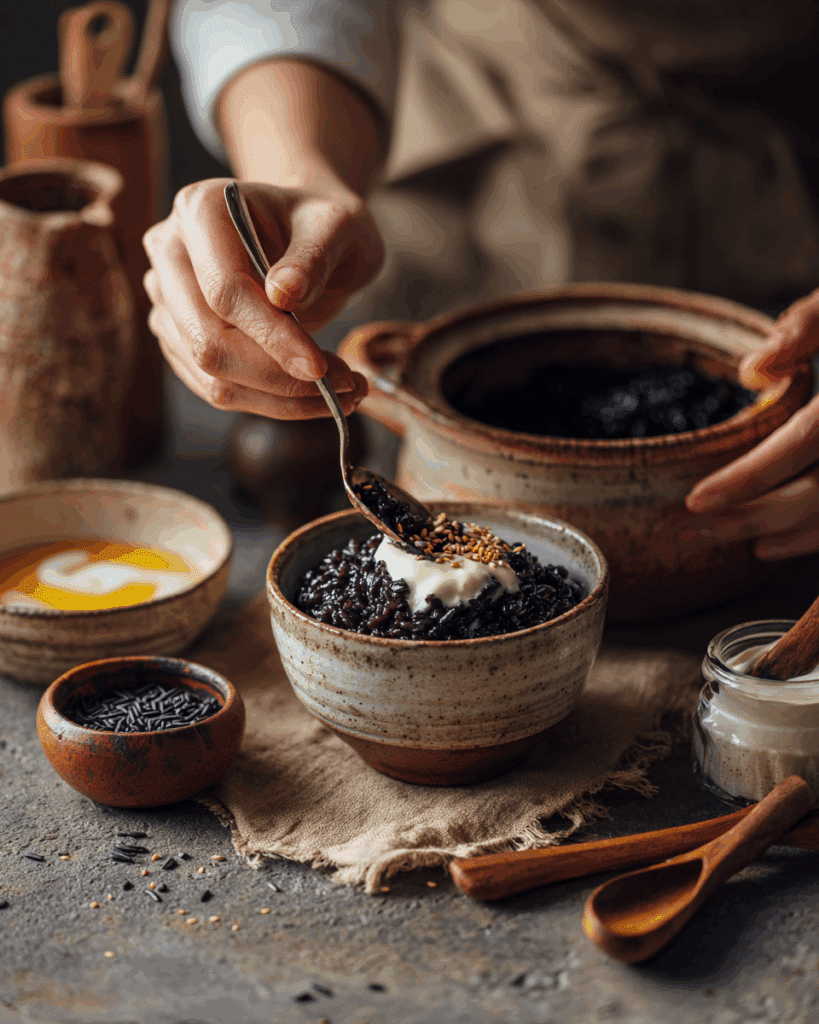
For a fruity variation, The Woks of Life shares an excellent take on black sticky rice paired with mango that complements this base recipe.
Pro Tips for Success
- Stir often during the final 15 minutes to avoid burnt rice.
- Use a non-stick or heavy-bottom pot to minimize sticking.
- Don’t skip the salt in the coconut cream—it sharpens the contrast between creamy and sweet.
- Serve warm or chilled depending on the season. Warm pudding is comforting, while chilled pudding feels refreshing and tropical.
Nutritional Notes
This dessert is naturally vegan and gluten-free, and thanks to the black glutinous rice, it’s packed with beneficial antioxidants. It’s also surprisingly filling due to its high fiber content.
For a dietitian’s perspective on black rice and its health perks, take a look at Joyful Eating Nutrition’s guide to black rice pudding, which covers both taste and nutrition benefits in detail.
If you’re a fan of cozy Thai sweets, check out Thai Pink Milk Drink: A Viral Thai Beverage You’ll Love as a colorful and complementary refreshment to serve with your pudding.
Common Variations and Regional Twists on Thai Black Sticky Rice Pudding
Embracing Diversity Across Thailand
While the classic version of Thai Black Sticky Rice Pudding follows a recognizable pattern of ingredients and method, the dessert evolves slightly depending on the region and even the family tradition. These variations add richness to the dish’s story and invite home cooks to explore new layers of flavor without compromising its identity.
One of the most beloved regional twists involves serving the pudding chilled. In northern Thailand, it’s common to refrigerate the pudding and coconut cream separately, then combine them just before serving. This version is especially refreshing in tropical heat, giving the dish a firm yet creamy texture that’s incredibly satisfying.
Another regional favorite includes stirring chunks of cooked taro or sweet potato into the pudding. These root vegetables introduce mild sweetness and earthy undertones that complement the nutty flavor of black glutinous rice. The chewy texture of taro blends seamlessly with the stickiness of the rice, creating a heartier dessert experience.
Coconut Variations That Change the Flavor Profile
Although coconut cream is a standard topping for Thai Black Sticky Rice Pudding, the coconut element can vary as well. In central Thai households, many recipes use both coconut milk during the cooking process and coconut cream as a final drizzle. This double-layer of coconut enhances the richness and creates a silkier mouthfeel.
Some cooks add a bit of coconut oil to the topping to intensify the aroma and provide a glossy finish. Others toast shredded coconut until golden brown and stir it directly into the pudding, turning every bite into a play of creamy and crunchy textures.
Adding pandan extract is another twist that has become popular in recent years. A few drops can boost the floral scent, especially when pandan leaves are not available. This shortcut is particularly useful outside Thailand, where fresh pandan may be difficult to find.
Fruit and Nut Toppings
Fresh fruit is one of the easiest and most vibrant ways to transform Thai Black Sticky Rice Pudding. While mango is the most common pairing, other tropical fruits like jackfruit, lychee, and longan are equally delightful. These fruits add natural sweetness, bright acidity, and a pop of color that makes the dessert visually appealing.
In some modern interpretations, a handful of raisins or chopped dates is stirred into the pudding during the final cooking minutes. This adds bursts of sweetness and a chewy texture that blends beautifully with the black sticky rice.
Crushed peanuts or sesame seeds are another creative twist, commonly found in urban Thai cafes. These toppings bring in a subtle roasted flavor and elevate the dish with a satisfying crunch.
Sweet and Salty Experiments
Thai desserts often strike a balance between sweet and salty, and Thai Black Sticky Rice Pudding is no exception. While the classic version uses a light touch of salt in the coconut cream, some modern recipes go bolder, increasing the salt to emphasize contrast.
This version is sometimes referred to as “salty-sweet pudding” and offers a flavor profile that’s deeply satisfying. The heightened saltiness makes the natural sweetness of the black glutinous rice more pronounced, giving the dessert a more complex taste without the need for extra sugar.
Personalizing Your Own Version
Part of the joy in cooking Thai Black Sticky Rice Pudding at home is the freedom to adapt it. You can control the sweetness level, adjust the coconut topping’s richness, and experiment with different textures or toppings until you find your perfect version.
If you prefer less sugar, reduce the palm sugar slightly and rely on the rice’s natural nuttiness. For a silkier feel, blend a small amount of the cooked pudding into a puree before mixing it back in. Want more crunch? Add candied ginger or toasted nuts. These personal adjustments don’t make the dish less authentic—they make it yours.
Above all, the versatility of Thai Black Sticky Rice Pudding is what keeps it timeless. Whether you serve it warm in traditional bowls, chilled in dessert glasses, or topped with fresh fruit at your next dinner party, this humble Thai dessert can be as classic or as contemporary as you wish.
Nutritional Benefits of Thai Black Sticky Rice Pudding
More Than Just a Sweet Treat
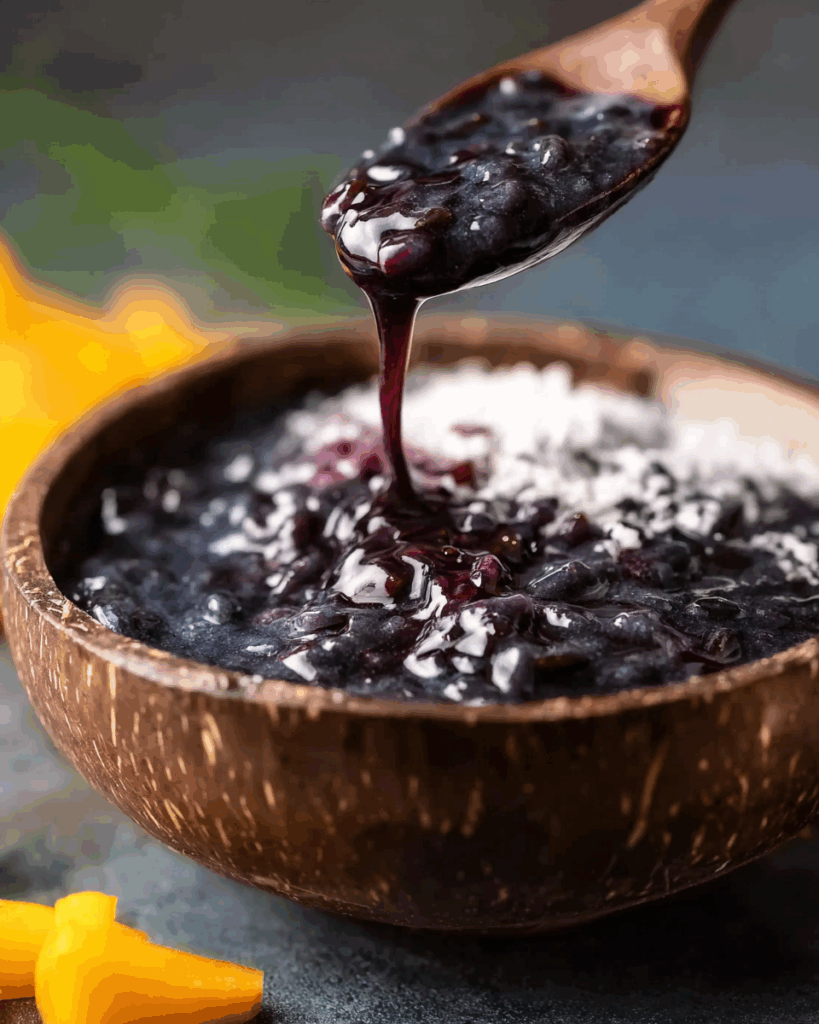
While Thai Black Sticky Rice Pudding is undeniably delicious, it’s also surprisingly nutritious. It offers a rare combination of indulgence and health benefits, especially compared to many Western-style desserts. From antioxidants to fiber, this traditional Thai dish brings more to the table than just flavor.
Black glutinous rice, the foundation of Thai Black Sticky Rice Pudding, is naturally rich in anthocyanins. These are the same powerful antioxidants found in dark-colored fruits like blueberries and blackberries. Anthocyanins help reduce inflammation, combat oxidative stress, and support heart health. The deep purple hue of the rice is a visual cue to its antioxidant strength, making it a smarter choice for dessert lovers who care about wellness.
High in Fiber and Digestive Friendly
Compared to white rice, black glutinous rice has a higher fiber content. This makes Thai Black Sticky Rice Pudding a more filling dessert that digests slowly and keeps you satisfied longer. The fiber also supports gut health by promoting regular digestion and feeding beneficial gut bacteria.
Adding toppings like fresh fruit or shredded coconut can boost the fiber content even more, creating a well-rounded and nourishing snack or after-meal treat. It’s a dessert that leaves you satisfied without a sugar crash.
Naturally Gluten-Free and Vegan
For those with dietary restrictions, Thai Black Sticky Rice Pudding checks a lot of boxes. The dish is entirely gluten-free because glutinous rice doesn’t contain gluten, despite the name. It’s also vegan, as it uses coconut cream instead of dairy. This makes it suitable for individuals with lactose intolerance or those following a plant-based lifestyle.
The coconut cream topping provides healthy fats that support energy levels and brain function. When paired with the complex carbohydrates from the rice, this balance creates a dessert that fuels the body while pleasing the palate.
Low in Processed Ingredients
Traditional recipes for Thai Black Sticky Rice Pudding stick to natural, minimally processed ingredients. Palm sugar, coconut cream, and pandan leaves are staples in Thai kitchens and provide layers of flavor without relying on artificial additives. When you make this dish at home, you have full control over the quality and quantity of ingredients.
That means you can skip unnecessary preservatives and added sugars while enjoying a dessert that’s as wholesome as it is flavorful. Even when modified with toppings like fruit or nuts, Thai Black Sticky Rice Pudding stays true to its roots—natural, nourishing, and deeply satisfying.
A Great Post-Meal Option
Thanks to its mix of fiber, healthy fat, and complex carbs, Thai Black Sticky Rice Pudding is a great option for rounding off a meal. Unlike heavier desserts that can leave you feeling sluggish, this pudding feels indulgent yet light. The chewy texture slows down your eating pace, helping with portion control and mindful eating.
Even when served chilled, it doesn’t lose its satisfying nature. Whether you enjoy it after lunch or as an evening treat, this dessert helps maintain steady energy levels rather than sending your blood sugar on a rollercoaster.
Nutrient Breakdown Snapshot
Let’s take a closer look at what a typical serving of Thai Black Sticky Rice Pudding might provide:
- Calories: Moderate (depends on sugar and coconut cream quantity)
- Fiber: High, especially compared to standard desserts
- Fats: Healthy fats from coconut cream
- Sugar: Natural sugars from palm sugar (can be adjusted)
- Protein: Small amounts from rice and toppings
- Vitamins: B vitamins from rice, Vitamin E from coconut
- Minerals: Iron, magnesium, and potassium are present in small amounts
In summary, Thai Black Sticky Rice Pudding is not just about flavor it’s a smart choice for a dessert that aligns with your health goals. It’s proof that something sweet can also be good for you, especially when made with care and traditional ingredients.
How to Serve and Store Thai Black Sticky Rice Pudding
Traditional Thai Serving Style
In Thailand, Thai Black Sticky Rice Pudding is typically served warm in small bowls, often enjoyed after a light lunch or as a mid-afternoon sweet treat. The pudding is ladled in while still gently steaming, then topped with a swirl of salty coconut cream and a sprinkle of toasted coconut or sesame seeds. This warm presentation brings out the deep, nutty flavors of the black glutinous rice and contrasts beautifully with the rich creaminess of the topping.
When served this way, the texture of the rice is soft and slightly chewy, creating a luxurious mouthfeel that makes the dish so memorable. The warmth also enhances the aroma of pandan and palm sugar, giving the entire experience a comforting feel that appeals to all the senses. If you want the most authentic taste, serving Thai Black Sticky Rice Pudding warm is highly recommended.
Chilled for a Refreshing Twist
Although the warm version is traditional, chilling Thai Black Sticky Rice Pudding is a popular modern option, especially during hot weather. When refrigerated, the pudding thickens slightly and becomes even chewier. Some people actually prefer this texture, as it feels more like a dense dessert than a soft porridge.
To serve it chilled, prepare the pudding and let it cool to room temperature before storing it in the fridge. Keep the coconut cream separate and add it only when ready to serve. Garnishing with fresh mango, lychee, or even pomegranate seeds enhances the refreshing aspect of this version and adds a splash of color.
Toppings That Elevate the Experience
One of the joys of Thai Black Sticky Rice Pudding is the freedom to experiment with toppings. Classic choices like salted coconut cream and toasted shaved coconut offer contrast and richness. But you can also add tropical fruits like mango, pineapple, or banana slices for brightness and acidity.
Crushed peanuts or sesame seeds give a slight crunch and depth, while even a drizzle of condensed coconut milk can make the dish more indulgent. Some cooks add a dusting of cinnamon or nutmeg for a fusion twist, though these aren’t typically found in Thai versions.
Every topping changes the experience slightly, so don’t hesitate to explore. Whether you keep it traditional or go creative, the pudding always holds its identity at the center.
Best Storage Practices
If you’ve made a batch of Thai Black Sticky Rice Pudding and plan to enjoy it over a few days, storage is simple. Place the pudding in an airtight container and store it in the refrigerator for up to 4 days. The pudding will naturally thicken as it cools due to the starch in the rice.
For the best texture, reheat portions gently on the stove or in the microwave with a splash of water to loosen it. Stir well before serving to ensure even consistency. If serving cold, let it sit at room temperature for 10 minutes before adding your toppings, as this softens the texture and brings out the flavors more vividly.
Freezing the Pudding
Although not common, Thai Black Sticky Rice Pudding can be frozen. If you choose this method, cool the pudding completely and portion it into freezer-safe containers. Avoid freezing the coconut cream topping prepare that fresh when you plan to serve it. Frozen pudding can be stored for up to two months.
When ready to eat, thaw the pudding in the refrigerator overnight, then reheat it on the stove with a bit of water or coconut milk until smooth and hot. This process helps revive the original texture and flavor, making it taste almost as fresh as the day it was made.
Portioning for Guests or Meal Prep
Thai Black Sticky Rice Pudding is perfect for meal prepping or serving to guests. It can be portioned into small dessert bowls, mason jars, or ramekins and stored in the fridge with lids or plastic wrap. Simply add the toppings right before serving to maintain their texture and freshness.
Whether you’re preparing it ahead for a dinner party or packing it in lunchboxes for the week, this dessert holds up beautifully and is always ready to deliver flavor and comfort on demand.
Thai Black Sticky Rice Pudding is more than a one-time indulgence. With the right storage and serving techniques, it becomes a dessert that fits easily into your weekly rotation. Warm or cold, plain or topped, fresh or leftover this pudding keeps its magic in every form.
Common Mistakes to Avoid When Making Thai Black Sticky Rice Pudding
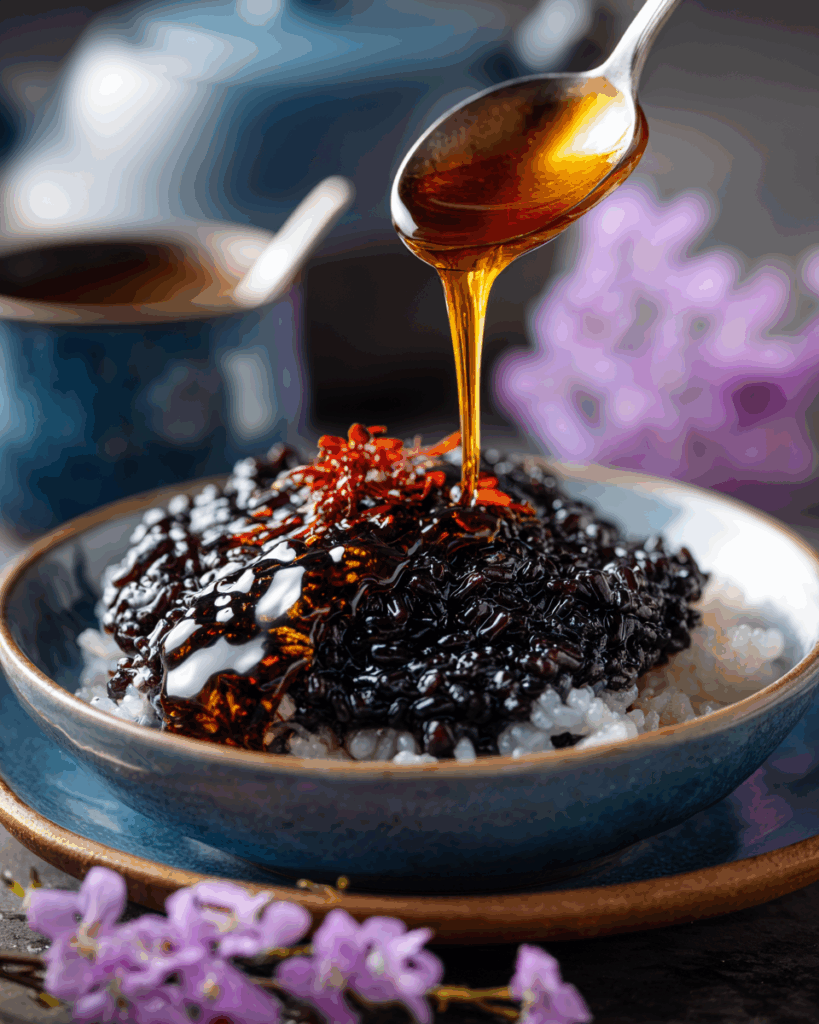
Not Soaking the Rice Long Enough
One of the biggest mistakes people make when preparing Thai Black Sticky Rice Pudding is skipping or shortening the soaking time. Soaking the rice for at least 4 hours, ideally overnight, is essential. Without this step, the black glutinous rice takes much longer to cook and may remain firm in the center. Soaked rice also releases more starch during cooking, which is crucial for achieving the creamy consistency this dessert is known for.
To get the most authentic results, always start with well-soaked rice. It sets the foundation for the texture and ensures your Thai Black Sticky Rice Pudding turns out soft and chewy, not tough or uneven.
Using Too Much Heat
Cooking the pudding at high heat is another mistake that can ruin your efforts. The rice needs to simmer gently, not boil rapidly. High heat causes the water to evaporate too quickly, leaving the rice undercooked and the texture gritty. It also increases the risk of burning, especially toward the end of cooking when the mixture thickens.
A steady low simmer is the secret to perfect Thai Black Sticky Rice Pudding. It allows the rice to absorb water gradually and release its starches, resulting in a pudding that’s luscious and smooth.
Adding Sugar Too Early
Another common misstep is adding palm sugar at the beginning of cooking. While it might seem convenient, this can interfere with how the rice absorbs water. Sugar tightens the outer surface of the rice, making it harder for moisture to penetrate. The right approach is to wait until the rice is fully tender before stirring in the sugar and salt.
This method guarantees that your Thai Black Sticky Rice Pudding cooks evenly and that the sweetness blends harmoniously at the end without compromising texture.
Not Stirring Enough
Stirring may seem tedious, but it’s critical during the final 15 minutes of cooking. As the water reduces and the rice thickens, it becomes more likely to stick to the bottom of the pot. Failing to stir often can lead to scorched rice and uneven texture.
Frequent stirring during the last stages of cooking prevents burning and ensures that every grain of rice contributes to the pudding’s velvety finish. It also distributes the heat more evenly throughout the mixture.
Using Low-Quality Coconut Cream
The richness of Thai Black Sticky Rice Pudding depends heavily on the coconut cream topping. Choosing thin or watery coconut milk instead of thick coconut cream weakens the flavor and texture of the dish. Always look for full-fat coconut cream and avoid brands that contain too many additives or thickeners.
The coconut cream should have a thick, scoopable consistency that contrasts beautifully with the pudding. It’s this luxurious layer that makes Thai Black Sticky Rice Pudding so decadent and satisfying.
Skipping the Salt
Many home cooks hesitate to add salt to desserts, but in Thai cuisine, salt is vital to balance sweetness. Omitting salt in both the pudding and the coconut cream results in a flat flavor profile. That tiny pinch of salt sharpens the coconut flavor and enhances the natural sweetness of the rice and sugar.
Always remember: a little salt goes a long way in making your Thai Black Sticky Rice Pudding taste authentic and multidimensional.
Overcooking or Undercooking the Rice
Finding the right doneness is key. Undercooked rice feels tough and unpleasant, while overcooked rice becomes mushy and may lose its structure entirely. The goal is a perfect balance: grains that are fully cooked and tender, yet still hold their shape.
Taste the rice toward the end of cooking to check for doneness. When done right, Thai Black Sticky Rice Pudding has a chewy, satisfying bite that never feels heavy or soggy.
Neglecting Texture Balance
This dessert is all about texture. From the chewiness of the rice to the creaminess of the coconut, every layer should be thoughtfully prepared. Too much coconut cream can make it overly rich. Too little and the dessert may feel dry. The rice should flow slowly off the spoon, not be stiff or overly runny.
Attention to texture is what separates a good Thai Black Sticky Rice Pudding from a great one. When the balance is right, it’s comforting, luxurious, and deeply satisfying.
Thai Black Sticky Rice Pudding for Special Occasions and Everyday Enjoyment
A Dish for Celebrations and Daily Comfort
Thai Black Sticky Rice Pudding is more than a dessert—it’s a cultural comfort, a festive delight, and a dish that effortlessly fits into both special occasions and regular daily meals. Its simplicity, paired with luxurious flavor and texture, makes it an ideal choice for Thai celebrations like Songkran (Thai New Year), family gatherings, and temple fairs. But it’s just as welcome on a cozy night at home when you’re craving something sweet and warm.
This dessert’s versatility comes from its ingredients. With just rice, water, palm sugar, salt, and coconut cream, Thai Black Sticky Rice Pudding can be prepared with pantry staples and still feel rich enough for guests. That’s one of the reasons it has remained a Thai favorite for generations.
Making It the Centerpiece of a Thai Dessert Table
For traditional events or cultural dinners, Thai Black Sticky Rice Pudding often takes its place among an array of sweets. It pairs beautifully with other Thai desserts, especially those that also use coconut or glutinous rice. The deep purple color of the pudding adds visual drama to the table and stands out against the golden tones of dishes like egg yolk-based sweets or vibrant mango.
Its strong color and chewy texture also provide a welcome contrast to lighter desserts. Serving it in individual bowls or elegant glasses with coconut cream and toasted coconut on top adds a touch of sophistication while keeping things traditional.
When hosting a Thai-themed dinner, featuring Thai Black Sticky Rice Pudding as the finale leaves a lasting impression. It’s a dish that satisfies the palate and sparks curiosity, especially among guests who haven’t tried it before.
Everyday Comfort You Can Prepare in Advance
Beyond celebrations, Thai Black Sticky Rice Pudding fits beautifully into everyday routines. It can be made ahead of time and stored in the refrigerator for several days, making it a convenient option for those looking to add a nourishing, plant-based dessert into their weekly meal prep.
Enjoying a warm bowl after dinner or reaching for a chilled serving as a midday snack brings both comfort and satisfaction. The pudding’s natural sweetness and fiber-rich content make it a balanced treat that won’t leave you feeling overly full or sluggish. It’s the kind of dessert that feels indulgent without being heavy.
You can even adjust the level of sweetness or portion sizes to match your needs. For children, smaller portions topped with fruit may be ideal, while adults might appreciate a bolder contrast of coconut cream and toasted nuts.
A Thoughtful Gift from the Kitchen
In Thai culture, sharing food is a meaningful gesture. Thai Black Sticky Rice Pudding makes a thoughtful and unique homemade gift. It can be spooned into mason jars, topped with coconut cream and fruit, and gifted as a token of care or appreciation. Its long shelf life in the fridge and its ability to be served warm or cold make it travel-friendly and flexible.
Gifting this dessert is especially suitable for new parents, neighbors, or friends recovering from illness. Its ease of digestion and comforting nature make it not only tasty but healing in spirit.
Celebrating Tradition in a Modern Kitchen
Preparing Thai Black Sticky Rice Pudding at home is a way to connect with Thai culinary heritage while embracing modern convenience. Whether you’re using traditional methods or your favorite shortcuts, what matters most is the intention behind the dish.
Even in today’s fast-paced lifestyle, taking time to soak rice, stir slowly, and balance sweet with salt allows you to create something soulful. The act of preparing Thai Black Sticky Rice Pudding itself becomes a ritual a way to slow down, appreciate each ingredient, and bring cultural depth to your dining table.
It’s a dish that reminds us that comfort doesn’t have to be complicated and that tradition can be both celebrated and personalized.
Conclusion
Thai Black Sticky Rice Pudding is more than just a sweet dish—it’s a heartfelt expression of Thai culinary heritage. With its chewy texture, nutty depth, and creamy coconut topping, it delivers a sensory experience that speaks to both comfort and celebration. Whether you enjoy it warm on a cozy evening or serve it chilled at a festive gathering, this pudding captures everything we love about Thai desserts: simplicity, richness, and balance.
Throughout this article, we’ve explored the origins, ingredients, cooking techniques, variations, and cultural significance of Thai Black Sticky Rice Pudding. We’ve walked through how to prepare it step-by-step, the health benefits it offers, and how to make it part of everyday life or special occasions.
From the first soak of the rice to the final drizzle of coconut cream, every step is an invitation to slow down and savor. And with so many ways to customize the dish—by adjusting sweetness, changing toppings, or playing with textures—you can always make it your own without losing its authentic soul.
Looking for inspiration? Try Massaman Chicken Curry So Good It Feels Like Magic as a savory complement to your pudding for a complete Thai dining experience.
FAQ About Thai Black Sticky Rice Pudding
What does Thai black rice taste like?
Thai black rice has a distinct flavor profile. It’s nutty, earthy, and slightly sweet even before sugar is added. When cooked, it develops a deep richness that sets it apart from white rice or jasmine rice. This unique flavor becomes even more pronounced in Thai Black Sticky Rice Pudding, where it’s enhanced by palm sugar, salt, and coconut cream.
Unlike white rice, which can be bland on its own, Thai black rice carries its own character. That’s why Thai Black Sticky Rice Pudding is so memorable—it doesn’t rely solely on sugar or toppings to be delicious. The rice itself contributes a bold taste that complements the creamy coconut and caramel notes from the palm sugar.
Whether you’re enjoying it plain or topped with fruit and nuts, the flavor of Thai black rice stands at the heart of the dish. Its complexity is what makes Thai Black Sticky Rice Pudding so unique among global desserts.
Is Thai black rice sticky?
Absolutely. Thai black rice, also known as black glutinous rice or black sticky rice, becomes naturally sticky when cooked. Despite being called “glutinous,” it contains no gluten. The term refers to its glue-like texture, which helps it bind together once fully cooked. This sticky quality is what makes it perfect for desserts like Thai Black Sticky Rice Pudding.
The texture is chewy but soft, offering a pleasant resistance with every bite. Unlike other sticky rice used for savory dishes, black sticky rice brings a slightly nutty and earthy taste, which pairs wonderfully with sweet coconut toppings.
In Thai Black Sticky Rice Pudding, this stickiness is essential. It holds the pudding together and creates the dense, creamy body that makes this dessert so iconic. Without that natural stickiness, the dish wouldn’t achieve its signature consistency.
Can you use Thai sticky rice for rice pudding?
Yes, Thai sticky rice—especially black glutinous rice—is ideal for making rice pudding. Unlike standard rice varieties, Thai sticky rice has a naturally sticky texture when cooked, which helps create the thick, creamy consistency expected in Thai Black Sticky Rice Pudding. In fact, black sticky rice is specifically chosen for this dish because of its chewy bite and ability to hold up well during long cooking times without breaking down.
The rice not only adds structure but also a rich color and earthy flavor that you can’t replicate with white or jasmine rice. Using Thai sticky rice ensures authenticity and enhances the texture, making the pudding both visually appealing and deeply satisfying.
What is black rice pudding made of?
Thai Black Sticky Rice Pudding is made primarily from black glutinous rice, water, palm sugar, and salt. For enhanced flavor and aroma, pandan leaves are commonly simmered with the rice. Once the rice reaches a soft, creamy consistency, it’s topped with rich coconut cream that’s lightly salted to balance the sweetness. Some variations also include toasted coconut, fresh mango, or crushed peanuts for added texture and flavor. This combination of ingredients gives the pudding its chewy texture, nutty depth, and sweet-salty richness.
The main appeal of Thai Black Sticky Rice Pudding is the harmony of simple, whole-food ingredients coming together in a dish that feels both traditional and luxurious. Whether enjoyed warm or cold, it always satisfies with its smooth finish and fragrant undertones.

